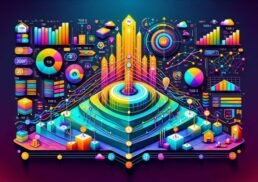Imagine a world where interior AI design ideas come to life with the power of artificial intelligence. The year 2023 has witnessed remarkable advancements in AI-driven interior AI design, transforming the way designers work and creating stunning, personalized spaces. As we dive into the latest trends and tools, let’s explore how AI is revolutionizing the industry, offering unprecedented automation, personalization, and visualization capabilities for both professionals and amateurs alike.
In this journey, we’ll uncover the transformative power of AI in interior AI design, discover the top AI-powered tools in 2023, compare their features and usability, and learn how to implement AI in your design projects to maximize benefits and stay ahead of the curve.
Table of Contents
Key Takeaways
AI has transformed the interior design industry, offering new tools to create personalized spaces and boost creativity.
AI technology is revolutionizing traditional interior design by streamlining workflows, reducing costs and providing innovative solutions.
Various AI powered tools have emerged in 2023 with unique features that cater to various styles & preferences which should be carefully considered when selecting one for a project.
The Power of AI in Interior Design
The integration of AI in interior design has opened up new possibilities in creating aesthetically pleasing and personalized spaces. AI interior design tools, which automate processes and ensure precision, have turned into indispensable assets for interior designers, allowing them to:
Boost their creativity
Generate unique design ideas
Interpret clients’ wishes
Suggest the most fitting design elements
The benefits of using AI in interior design are numerous.
Additionally, the concept of AI-driven sustainability is becoming popular in the industry. AI tools help designers make eco-friendly choices by analyzing data to pinpoint genuinely sustainable materials and design elements. The future of interior design is undoubtedly intertwined with artificial intelligence, and embracing this innovation means staying ahead in the ever-evolving world of design.
How AI Transforms Traditional Interior Design
Gone are the days of laborious manual calculations, as AI interior design tools, including the innovative ai interior design app, have made it possible to:
Provide precise cost estimates quickly
Enable designers to adjust their designs to meet clients’ budgets
Find interior design inspiration within financial constraints.
Furthermore, AI proves beneficial in material selection, as it can assess your design style and accurately select the most appropriate material based on exact measurements, whether you’re designing a living room, bedroom, or any other space.
AI technology is transforming traditional interior design in numerous ways, such as streamlining workflows, reducing costs, and providing innovative design solutions. Adoption of AI allows designers to concentrate on their creativity while intelligent algorithms handle mundane tasks, resulting in a more efficient and enjoyable design process.
AI-Driven Trends in Interior Design
AI-driven trends in interior design are reshaping the way we approach and experience spaces, including various interior design projects. They include:
Space planning
Material selection
Lighting design
Personalization
3D rendering
Sustainability
These trends cater to various design styles.
Space planning, a fundamental component of any interior design, involves assessing the space and determining furniture measurements to ensure the room is planned to its fullest potential, which can be achieved using a room planner tool.
Material selection plays a vital role in interior design, paving the way for the creation of a specific atmosphere within a space. AI can be utilized to customize a space to the individual’s specifications, ensuring a truly personalized design. Additionally, AI can create lifelike 3D renderings of a space, allowing designers and clients to visualize the space before its construction.
Finally, with growing environmental concerns, AI-driven sustainability in interior design helps identify sustainable materials and design options, making eco-friendly choices more accessible.
For more info, visit Transforming Interiors: How AI is Revolutionizing Home Design
Top AI-Powered Interior Design Tools in 2023
The year 2023 has witnessed an impressive array of AI-powered interior design tools, each offering unique features and benefits to cater to various design styles and preferences. This section will spotlight the top tools such as:
Foyr Neo
Houzz Pro
SketchUp
RoomSketcher
Space Designer 3D
RoomGPT
We will delve into their features, usability, and unique selling points to assist you in selecting the optimal tool for your design projects.
Foyr Neo is a powerful AI-driven interior design tool that allows users to create stunning interiors.
Foyr Neo: Streamlining the Design Process
Foyr Neo is a comprehensive AI-powered interior design tool that simplifies the design process and offers a wide range of features for designers. Streamlining intricate workflows, cutting expenses, and eliminating the requirement for multiple software and plugins, Foyr Neo has become a game-changer in the interior design industry.
With its user-friendly interface, Foyr Neo facilitates a simplified design process, allowing users to create 3D models of their spaces and visualize their design ideas. Its comprehensive set of features makes it an invaluable tool for both professionals and amateurs looking to bring their interior design ideas to life.
Houzz Pro: Matching Products to Ideas
Houzz Pro is an all-in-one application designed for contractors and designers that utilizes AI to assist users in locating products that correspond to a reference image. Its visual match tool is a distinguishing feature that makes it stand out among other AI-powered interior design tools.
Leveraging AI, Houzz Pro analyzes reference images and identifies products in its database that match the designer’s ideas, allowing for an expedited product discovery process. This can facilitate the product selection process, as well as grant access to a broad array of products, thereby saving designers time and effort.
SketchUp: Customization Made Easy
SketchUp is a premier 3D design software that enables users to:
Construct and modify both 2D and 3D models with an intuitive and powerful toolset
Customize objects and materials easily
Receive furniture material suggestions to assist in achieving desired designs
As an AI-enhanced interior design software, SketchUp offers a range of features to enhance the design process.
Offering a free version, SketchUp allows users to:
Experiment with different design options without any financial commitment
Utilize its user-friendly interface
Take advantage of its advanced AI capabilities
These features make SketchUp an invaluable tool for designers looking to bring their interior design ideas to life.
RoomSketcher: Turning Sketches into Reality
RoomSketcher is an AI-powered tool that offers the following features as an AI room planner:
Transforms hand-drawn sketches into detailed floor plans with accurately mapped design elements
User-friendly platform for generating 2D and 3D floor plans and home designs
Extensive library of furniture and decor items from authentic brands, facilitating design with actual products
The easy-to-use interface of RoomSketcher allows users to bring their sketches to life while visualizing how their room would appear with various furniture and decor items. By providing designers with a realistic 3D representation of their space, RoomSketcher helps them make informed decisions on design elements, ensuring the final result is both functional and visually appealing.
Space Designer 3D: User-Friendly Design Creation
Space Designer 3D is a user-friendly, cloud-based interior design software with AI capabilities that create designs based on user preferences and analyze existing floor plans for inspiration. Its intuitive tools and user-friendly interface provide a convenient design creation and communication experience for both designers and clients.
Offering features such as:
3D visualization
Floor plan creation
Furniture selection
AI-driven design suggestions
Space Designer 3D is an ideal tool for designers looking to create captivating and personalized spaces. Its emphasis on ease of use and design versatility makes it an invaluable asset for anyone looking to bring their interior design ideas to life.
RoomGPT: Lifelike 3D Depictions and Product Selection
RoomGPT offers AI-driven interior design solutions with lifelike 3D depictions and a vast selection of furniture and decor products. By leveraging machine learning algorithms, RoomGPT creates a 3D model of the room based on the uploaded photo, allowing users to visualize how their room would appear with various furniture and decor items.
With its wide array of products and styles, RoomGPT makes it effortless to find the ideal items for any room type. The user-friendly interface and advanced AI capabilities make RoomGPT an invaluable tool for designers looking to create captivating and personalized spaces, staying ahead in the ever-evolving world of interior design.
Comparing AI Interior Design Tools: Features, Usability, and Pricing
Deciding on the best AI interior design tool for your needs requires a comparison of the features, usability, and pricing of each tool. Some factors to consider include:
Unique features offered by each tool
Compatibility with your design style
User-friendly interface
Pricing options and affordability
By evaluating these factors, you can determine which AI interior design tool is the best fit for your needs.
A comparison table of the top AI interior design tools can help you weigh the pros and cons of each tool, allowing you to find the perfect match for your design projects. By carefully evaluating the features, usability, and pricing, you can ensure that you’re leveraging the full potential of AI in interior design and creating spaces that are both visually stunning and functional.
Implementing AI in Your Design Projects
The integration of AI into your design projects can significantly transform your work by offering numerous benefits such as time and cost savings, along with more accurate and personalized designs. However, to fully harness the power of AI in interior design, it’s crucial to choose the right AI tool, maximize its benefits, and embrace the learning curve.
Selecting the appropriate tool is only the first step in the journey. Investing time in understanding the tool’s features and functionality, as well as learning how to use it correctly, will ensure that you’re maximizing the benefits of AI in your design projects. Embrace the learning curve and stay committed to mastering the AI tool of your choice to create stunning and personalized spaces that cater to your clients’ needs and preferences.
Choosing the Right AI Tool
When choosing an AI tool, it’s important to assess each tool’s features, usability, and pricing to ensure it meets your requirements. Consider factors such as:
Machine learning algorithms
Workload reduction capabilities
Functionality
Scalability
Ease of integration
Compatibility with existing systems
Performance
Security
Reliability
Data security
Privacy
By thoroughly assessing each tool, you can make an informed decision and ensure that you’re leveraging the full potential of AI in your design projects.
Maximizing AI Tool Benefits
For optimal use of an AI tool, investing time and effort to fully understand its features and usage is a prerequisite.
Additionally, staying up to date with the latest trends, technologies, and innovations in the industry can help you make the most of your AI tool and remain competitive in the market. By continually refining your skills and embracing new advancements, you’ll be able to create captivating and personalized spaces that cater to your clients’ needs and preferences.
Embracing the Learning Curve
Adapting to a learning curve requires not only time and effort, but also the right tools and resources, which can entail costs. To approach the learning curve effectively, establish achievable objectives, divide tasks into manageable steps, and locate resources and mentors to assist with the learning process.
By embracing the learning curve and staying committed to mastering the AI tool of your choice, you’ll be able to create stunning and personalized spaces that cater to your clients’ needs and preferences.
Summary
The power of AI in interior design cannot be understated. From automating tasks and providing personalized design suggestions to enhancing visualization capabilities, AI has revolutionized the way designers work and create spaces. By exploring the latest AI-driven trends and tools in 2023, you can stay ahead in the ever-evolving world of interior design and create captivating, personalized spaces that cater to your clients’ needs and preferences.
As we conclude our journey, it’s crucial to remember that embracing the learning curve and implementing AI in your design projects can be a game-changer. Choose the right AI tool, maximize its benefits, and stay committed to mastering the tool to fully harness the power of AI in interior design. The future of interior design is intertwined with artificial intelligence, and it’s time to ride the wave of innovation.
Frequently Asked Questions
Is there any AI for interior design?
Yes, there are several AI-powered tools available for interior design. Homestyler, developed by Autodesk, and AI Room Planner are popular examples, offering a library of 3D models, furniture, and decor items to create and customize virtual spaces.
DecorMatters is another user-friendly AI app that brings together a community of design enthusiasts.
What is the arch AI interior designer?
Archi is an AI Interior Designer that allows you to quickly and easily generate photo-like images of your desired space. Its AI algorithms provide detailed recommendations on furniture, decor, color schemes, and more, tailored to each specific design style.
With AI Interior Designer, users can effortlessly visualize and explore endless design possibilities and create a cohesive and harmonious environment with ease.
What are the advantages of using AI in interior design?
AI in interior design brings several advantages, such as improving workflows, reducing costs, providing customized suggestions, and improving visualization capabilities.
What are the top AI-powered interior design tools in 2023?
In 2023, Foyr Neo, Houzz Pro, SketchUp, RoomSketcher, Space Designer 3D, and RoomGPT will be the top AI-powered interior design tools.
How can I choose the right AI tool for my interior design projects?
Choose the right AI tool for your interior design projects by evaluating the features, usability, and pricing of each option to ensure that it meets your needs and design style.
Take the time to research the different AI tools available and compare them to find the one that best fits your project. Consider the features, usability, and pricing of each option to make sure it meets your needs and design style.









